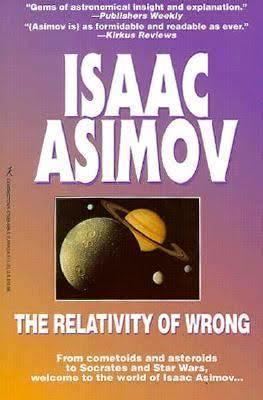8.4 /10 1 Votes8.4
Country United States Publication date 1988 ISBN 0-385-24473-8 | 4.2/5 Goodreads Language English Pages 225 Originally published 1988 Page count 225 | |||||||||||||||||||||||||||||||||
 | ||||||||||||||||||||||||||||||||||
Genres Mathematics, Essay, Science Similar Isaac Asimov books, F&SF Essay Collections books, Science books | ||||||||||||||||||||||||||||||||||
The relativity of wrong
The Relativity of Wrong is a collection of seventeen essays on science, written by Isaac Asimov. The book explores and contrasts the viewpoint that "all theories are proven wrong in time", arguing that there exist degrees of wrongness.
Contents
The book was the twentieth of a series of books collecting essays from The Magazine of Fantasy and Science Fiction. Like most of the essays Asimov wrote for F&SF, each one in The Relativity of Wrong begins with an autobiographical anecdote which serves to set the mood. Several of the essays form a sequence explaining the discovery and uses of isotopes.
Title essay
In the title essay, Asimov argues that there exist degrees of wrongness, and being wrong in one way is not necessarily as bad as being wrong in another way. For example, if a child spells the word sugar as "pqzzf", the child is clearly incorrect. Yet, Asimov says, a child who spells the word "shuger" (or in some other phonetic way) is "less wrong" than one who writes a random sequence of letters. Furthermore, a child who writes "sucrose" or "C12H22O11" completely disregards the "correct" spelling but shows a degree of knowledge about the real thing under study. Asimov proposes that a better test question would ask the student to spell sugar in as many ways as possible, justifying each.
Likewise, believing that the Earth is a sphere is less wrong than believing that the Earth is flat, but wrong nonetheless, since it is really an oblate spheroid or a reasonable approximation thereof. As the state of knowledge advanced, the statement of the Earth's shape became more refined, and each successive advance required a more careful and subtle investigation. Equating the wrongness of the theory that the Earth is flat with the wrongness of the theory that the Earth is a perfect sphere is wronger than wrong.
Asimov wrote "The Relativity of Wrong" in response to an "English Literature major" who criticized him for believing in scientific progress. This unnamed individual is portrayed by Asimov as having taken the postmodern viewpoint that all scientific explanations of the world are equally in error. Irritated, the rationalist Asimov put forth his views in his monthly F&SF column, and the result became the title essay of this collection.
